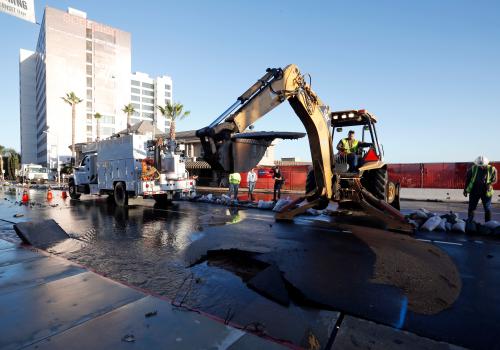Infrastructure policy discussions regularly highlight the need for new projects like wider highways and new transit lines. This make sense: voters and the media can’t ignore the infrastructure they see, and ribbon-cutting ceremonies are visible successes for politicians. But by focusing on “new” infrastructure projects, policymakers overlook the more economically significant challenge facing most of the country: maintenance.
Fortunately, that is changing.
The term deferred maintenance – defined by the U.S. Department of Treasury as any delayed repairs that can lead to safety hazards and other costs – is becoming a huge factor to consider among policymakers and practitioners at the state and local levels. For example, beyond the enormous price tag to maintain existing facilities, many local agencies and utilities are confronting a rising challenge to cover routine repair costs, as a new Brookings report on water infrastructure has shown. Even ordinary Americans are coming to grips with the country’s infrastructure maintenance backlog, thanks to comedians like John Oliver.
Beyond simply recognizing the maintenance challenge at hand, it is critical that governments are actually doing something about it
Beyond simply recognizing the maintenance challenge at hand, it is critical that governments are actually doing something about it. Fortunately, some cities are taking the lead by offering a no-nonsense, logical approach that should be considered nationally. While probably not the first guess of many, one city stands out in this respect: Mobile, Ala. By reframing its chronic infrastructure maintenance problem as an acute challenge of “infrastructure blight,” Mobile has managed to bring urgency and coherence to a seemingly abstract engineering challenge.
When Mayor Sandy Stimpson was first elected in 2013, Mobile had a $250 million backlog of deferred maintenance projects and no funds set aside to cover costs. It also had a sprawling number of blighted properties negatively affecting property values and crime rates. However, Stimpson, a civil engineer turned elected official, prioritized upgrading Mobile’s infrastructure as a cornerstone of improving local economic development.
Mobile’s leadership has made a strong case that “We must invest in ourselves before anyone else will invest in us,” and there is evidence that it’s working. To date, the city has allocated $21 million per year to systematically reduce its backlog of deferred maintenance projects, which range in scale from large drainage improvements to repaving sidewalks.
It is important to note that Mobile’s investments are not the result of finding new funding, but rather reframing the problem to prioritize maintenance. Below are four widely-applicable lessons from Mobile’s early maintenance success story:
· Engage communities early and often: As part of an update to the city’s master plan, Map for Mobile, leaders engaged residents early in the planning process to better understand local pain points for citizens – and gain strong public support. Through this community engagement the city began to zero-in on the concept of “infrastructure blight,” which acknowledges that infrastructure disrepair disproportionally affects underserved communities, and that problems (like abandoned and blighted properties) tend to be collocated in areas with visible infrastructure failures, like unpaved sidewalks and nuisance flooding.
· Empower engineers: Engineers don’t just belong in engineering departments. Mobile’s mayor is a former civil engineer, and the city has smartly recognized that if it is to reduce its backlog of deferred maintenance projects, infrastructure expertise cannot be siloed. Dianne Irby, Executive Director of Planning and Development, leads a cadre of civil engineers that hail from every city department involved in the capital planning process – including departments like real estate and asset management, not just engineering – to ensure that engineers have a seat at the table right from the get-go. The capital planning team, including engineers, meets with City Council members on a regular basis.
· Focus on visible infrastructure: Mobile has paired largely-invisible upgrades to below-ground assets, like sewer systems, with visible upgrades, like road and sidewalk repairs. This strategy has helped the city explain the importance of the repairs to citizens and has created a virtuous cycle of improvements.
· Tell the story, build trust: A final factor in Mobile’s early success has been its focus on communicating the importance of infrastructure improvements. On the Fix Mobile website, citizens can learn about the city’s capital improvement plan and see which specific projects are moving forward, in what order, and why. The city has even produced a series of videos highlighting the benefits of infrastructure improvements to the daily lives of residents. Knowing the reasons for and value of the road closures and services disruptions that often characterize large-scale infrastructure improvements can transform resident outrage into patience.
Because of their progress, Mobile is poised to take advantage of the next frontier of infrastructure maintenance innovations, including civic-tech
Mobile is a rare maintenance success story, but it offers lessons for other governments to consider, including the understanding that early and frequent community engagement are key, and that a focus on citizens’ pain points (like unpaved sidewalks) can garner support for broader improvements. Additionally, Mobile is showcasing how engineers should be empowered to solve community problems, and that to build trust, governments must tell the story. These are applicable lessons for any government struggling to upgrade and maintain infrastructure systems, irrespective of level, geography, or size.
Because of their progress, Mobile is poised to take advantage of the next frontier of infrastructure maintenance innovations, including civic-tech. Mobile is already using Instagram to document blighted properties, and moving forward, there are a wide-range of civic-tech solutions (like this one being used in Louisville, Ky.) that can help Mobile identify and make higher value infrastructure investments, as well as help dispel outdated plans or legacy projects entrenched in past budgets. Mobile’s combination of progress to date and the promise of new technologies may provide an optimistic roadmap toward tackling America’s infrastructure maintenance crisis after all.
The Brookings Institution is committed to quality, independence, and impact.
We are supported by a diverse array of funders. In line with our values and policies, each Brookings publication represents the sole views of its author(s).








Commentary
A road map to tackle America’s infrastructure maintenance crisis from Mobile, Alabama
November 9, 2017